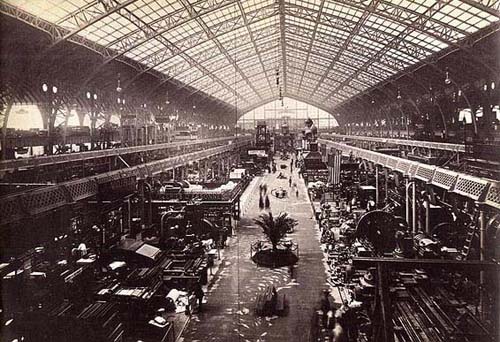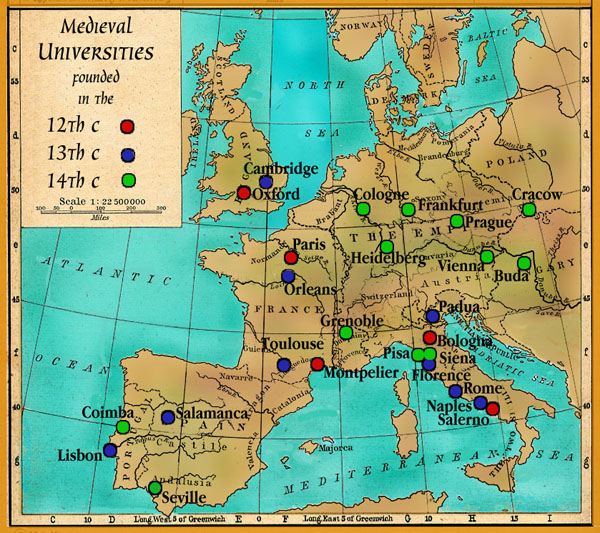
University of California, Irvine
Instructor: Dr. Barbara J. Becker

|
Lecture 9. Wedding Science and Technology
|
|
In The Maze of Ingenuity, author Arnold Pacey states that the revival of interest in techné during the 12th and 13th centuries was stimulated in part by the moral value authorities ascribed to manual labor (ch 1). But, he argues, it cannot explain the innovative successes of that period (ch 2). "For such an explanation, one necessarily has to talk about the ability to visualise a distant objective, the impulse to imagine something that is as yet unrealised, and the inclination to search for some practical way of translating vision into reality." In 1900, historian Henry Adams (1838-1918) visited the Galerie des Machines at the Paris Exposition. He composed an essay shortly afterward recalling his sense of astonishment at the display of new-fangled gizmos he had seen, particularly the dynamos which left him "lying in the Gallery of Machines..., his historical neck broken by the sudden irruption of forces totally new." "[T]o [me] the dynamo became a symbol of infinity. As [I] grew accustomed to the great gallery of machines, [I] began to feel the forty-foot dynamos as a moral force, much as the early Christians felt the Cross. The planet itself seemed less impressive, in its old-fashioned, deliberate, annual or daily revolution, than this huge wheel, revolving within arm's length at some vertiginous speed, and barely murmuring.... 
The Galerie des Machines at the 1889 Paris Exposition
In ch 12 of the novel, Riddley Walker, Riddley wonders as he gazes at the "jynt machines" he and Lissener have found in Fork Stoan: "How cud any 1 not want to get that shyning Power back from time back way back? How cud any 1 not want to be like them what had boats in the air and picters on the wind? How cud any 1 not want to see them shyning weals terning?" |
|
Think about an innovation of your own.
|
Guilds originated in primitive Germanic brotherhoods established to provide camaraderie, mutual aid, protection for trade secrets, and support in business ventures and disputes. The guild system flourished in the 13th-15th centuries, and maintained its influence so long as commerce was carried on independetly within each little town. The guild's management capabilities proved inadequate after trade and industry developed into a more widespread, interdependent network. 
Guildhall in York, England Craft guilds were syndicates of master craftsmen. Some of these guilds owned property, had their own chapels and patron saints, and made contributions to benefit the community at large such as donating stained-glass windows to the local cathedral. Although there was no one uniform organizational structure across all guilds in Europe, the principal aim of most was to regulate trade and preserve the status quo. To achieve that aim, they:
Technological progress during this period took place largely outside of the craft guilds. |
|
|
||
|
|
||
| Guild rules presented something of a challenge for masters who wanted to pass on their technical know-how to a new generation of craftsmen while keeping trade secrets safe within the confines of the group of individuals considered worthy to possess them. The apprentice system evolved over time to meet that challenge. Although details of the apprentice system's operation varied from place to place and from trade to trade, elements of the same basic structure could be found in many guilds. | ||
| ||
|
|
||
|
Scholarly Guilds → Universities By the 12th century, monasteries throughout Europe had served for centuries as the principal repositories of not only sacred knowledge but of secular knowledge (both techné and episteme) as well. By their very nature, these institutions were isolated communities. Although knowledge was successfully preserved and passed down, it remained accessible only to a limited population. As the 12th century drew to a close, a new institution devoted to knowledge preservation and transfer began to emerge -- the university -- which aimed to transmit knowledge to a wider, largely secular, population. These new-fangled entities were not "founded", per se. Rather, they grew out of the thriving guild structure of the period. Today we think of a university as a place where scholars gather to impart and gather knowledge. The medieval university was less a fixed place than a guild of scholars. People are mobile -- scholars of that time especially so. With no bulky tools required to ply their "trade", they could travel light. With Latin as their universal language, they could travel far and wide. If plague, war, pestilence or disputes with townfolk made a town inhospitable to the scholars who had settled there, they could pack up and move. In 1209, for example, the English town of Cambridge acquired a guild of scholars who had fled Oxford after a disagreement with that town's officials. Like their apprentice counterparts in the trade guilds, most of the scholars of the Middle Ages were adolescent boys. Townfolk needed help dealing with unwanted noise and property damage. The young scholars needed protection from physical abuse and excessive charges for room and board. Establishing a cooperative relationship between scholars and the communities in which they studied sometimes required intervention from higher authorities. This was the case in Cambridge. In 1231, King Henry III stepped in to protect the scholars from exploitation. At the same time, he decreed that only those scholars studying with a recognized master could remain in the town. There were two types of universities. Some, like the University of Paris, were guilds of masters. They developed from the old and more established monastery and cathedral school model in which teachers (all clerics who were independent of civil authorities) wielded considerable authority over what was to be taught and to whom. Others, like the University of Bologna, were guilds of students. They grew out of students' desire to control teaching (both instructors and curriculum), student selection and fees. Many teachers in Bologna-like universities were clerics, but others were physicians and lawyers employed in private practice. University instruction was divided into four faculties. The first and more basic faculty focused on instruction in the seven liberal Arts:
Once these Arts were mastered, qualifying students could then move on to pursue study in one or more of the other three faculties: Theology, Law, Medicine. |
||

|